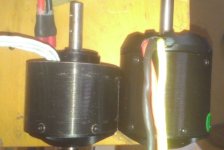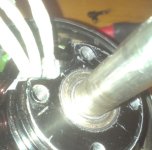Hi everyone, I am a new member to the site and have an exciting and ambitious first project. I put a quick post up in the 'general chat' area explaining it a few months ago, and I have spent that time glued to endless sphere, learning as much as I can! I am studying Mechanical Engineering in the UK, and my dissertation project is to build an ebike. The project isn't very restrictive at all, with my only aim being for it to reach a maximum (not sustained) speed of 40 mph. I am also very lucky because I have full access to the university's workshop, which includes CNC milling machines, lathes, MIG and TIG welders, plasma cutters, and more! Before I started the project I was a keen downhill mountain biker, but had absolutely no knowledge of electrical systems, or ebikes, so I really welcome any suggestions or corrections if I go off-track. So, I thought I would start by listing out the shopping list of parts I am hoping to use:
- 80100 7kw motor (180kv)
- 4 x 6s Zippy Flightmax 5000mah 40C LiPo batteries (to be run in 12s2p, not sure if this will be enough yet?)
- Hobbyking power supply
- Turnigy Accucel 6 charger
- Cell log
- 4 x low voltage alarms
- Castle Creations HV 160
- Magura throttle
- Cycle Analyst
- Neugart PLE gearbox
- 3-speed internally geared rear hub
- Custom jackshaft
- Custom frame
- Swingarm from DH bike (or possibly custom)
- High-end DH bicycle components
I am on a tight budget, so there are some things I would like, but I have had to compromise somewhere (would like an Astro 3220!). Now, I know the components I want to use for powering it, but I'm at the stage where I need to design a frame. I am really unsure whether I should go for a big DH style bike with fox 40 forks, and loads of travel (maybe even make it look more like an mx bike), or take inspiration from the Audi ebike, and go for a smaller, lightweight frame. Either way, I will be using a jackshaft, which will double as the rear wishbone mount (maintaining the correct chain tension). I have SolidWorks CAD so I will start to draw up some designs, and update you with my progress. Any ideas for frame inspiration, comments on the above, or advice would be greatly appreciated!
Thanks very much
- 80100 7kw motor (180kv)
- 4 x 6s Zippy Flightmax 5000mah 40C LiPo batteries (to be run in 12s2p, not sure if this will be enough yet?)
- Hobbyking power supply
- Turnigy Accucel 6 charger
- Cell log
- 4 x low voltage alarms
- Castle Creations HV 160
- Magura throttle
- Cycle Analyst
- Neugart PLE gearbox
- 3-speed internally geared rear hub
- Custom jackshaft
- Custom frame
- Swingarm from DH bike (or possibly custom)
- High-end DH bicycle components
I am on a tight budget, so there are some things I would like, but I have had to compromise somewhere (would like an Astro 3220!). Now, I know the components I want to use for powering it, but I'm at the stage where I need to design a frame. I am really unsure whether I should go for a big DH style bike with fox 40 forks, and loads of travel (maybe even make it look more like an mx bike), or take inspiration from the Audi ebike, and go for a smaller, lightweight frame. Either way, I will be using a jackshaft, which will double as the rear wishbone mount (maintaining the correct chain tension). I have SolidWorks CAD so I will start to draw up some designs, and update you with my progress. Any ideas for frame inspiration, comments on the above, or advice would be greatly appreciated!
Thanks very much





